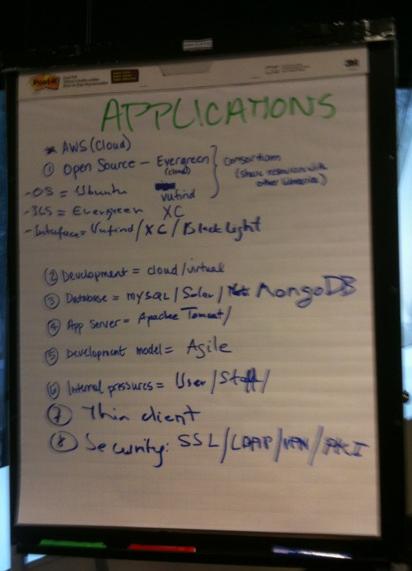This article is more than 5 years old.
This blog post gives an overview of my first experience at LITA. It also highlights some of the important points of the conference and demonstrates why some of the topics discussed made LITA Forum 2010 in Atlanta, GA, a wonderful experience.
I had the opportunity to attend the preconference on Virtualize IT presented by Maurice York, Head of the Library Information Technology at North Carolina State University. Some of the important parts of his talk included a great illustration of the latest trends in IT. These trends involve:
Virtualization illustrated by a suitcase and defined as one piece of hardware that does the work of several machines (virtual machines). It separates local operations from physical resources.
Cloud illustrated by a plug and defined as a set of pooled resources and services available over the internet, that offer elasticity, scalability, high availability, low upfront cost, pay for what you use etc to the user.
Grid illustrated by a PowerStation and defined as a massive parallel and distributed computing entity that is geographically disperse and loosely coupled computers, like a supercomputer or mainframe.
Maurice also talked about his library’s positive experience with thin clients that are currently deployed on public workstations in their library and are in the process of being rolled out to staff computers throughout the library. He emphasized on some of the great benefits of using thin clients and pointed out that only one single image needed to be changed to see the result on computers across the organization. Other benefits are centralized patching, virtualized applications (no conflict), live migration and failover, create and destroy virtual machines in a blink, access images and applications from any device (lending).
Green IT was also one of the important topics that Maurice introduced. According to him, mobile devices (iPhones, iPads, Blackberries, etc.) suck more power than any other electronic devices on campus because they are everywhere and need to be constantly charged. In addition, almost every student has one. He then pointed out that one server emits as much carbon dioxide (CO2) in one year as a Sport Utility Vehicle that gets 15mpg. Maurice believes that in about 10 to 20 years, “computing” will be “virtualization” as the world will realize that we are running out of power and to be able to accommodate the ever increasing demand in power which by the way “cannot be stored”, then the world will need to use one piece of hardware to perform the work of several machines, which is what virtualization is all about.
Some more ways of addressing this eventual penury of power includes adopting zero carbon emission strategies like wind, solar, geothermal, solar thermal etc. He also recommended moving data centers to “where the power is” like cloud computing, smart grids, and cyber infrastructure, as he pointed out the notions of “follow the wind”, Infrastructure as a Service, and trade offsets.
In order for libraries to keep up with future technology requirements, Maurice prescribed the need to perform a basic assessment of one’s institution including application suites, staff computing, networking services, power, data, facilities, as all these require particular attention. To him, in order to efficiently sustain users’ demand in term of computing resources, the library information technology support providers need to understand the infrastructure that they are running even if they don’t need to know it. This includes knowing their facilities people.
One of the final activities of the preconference involved working in small groups to talk about a make-believe of the library and come up with a fictitious ideal library. There were several groups and each one had a topic to discuss. One group had to design a library facility; another one was tasked to take care of networking in the library. My group was asked to focus on applications. This was interesting as I was the one who had to speak on behalf to the group and share our discussion with the whole conference attendees. In our group we decided to go open source on all applications. We also decide on hosting our services in the Amazon cloud, use Evergreen as our ILS, VuFind/XC/Backlight as our discovery interface, Ubuntu as our operating system, MySQL/ Solr/MongoDB as our database, Apache Tomcat as our web server, and Agile as our development model. We also agreed on deploying only thin client stations throughout the library and rely on SSL, LDAP, VPN, PKI, to configure security in the cloud.

As you can tell, the preconference was worth it and was an opportunity to network with others that are moving in the direction of virtualization whether it is with a private cloud like at NCSU, or with a public cloud that we are more in favor of at the ZSR Library.
My ultimate great experience was the presentation that Erik, Kevin, and I gave on Making your IT skills virtual during the main conference last Friday. I agree with Susan when she said that the presentation was successful. Since this was my first presentation at LITA (my first professional presentation), I felt extremely overwhelmed but had the opportunity to demonstrate my understanding of the part of the topic that I covered and responded to multiple questions that served to clarify in more depth what it takes to succeed in cloud computing. Our message got well received and several people lined up after the conference to have one-on-one discussions with each one of us.
This experience coupled with all the great sessions that I attended contributed to make this first LITA experience, a milestone in my efforts to fulfill my scholarship requirements.
2 Comments on ‘My first time at LITA’
Sounds like you got a lot out of it, JP. Congratulations on your first professional presentation!
Sounds like you got energized! Maurice is good at explaining stuff to my experience — glad you got to meet him.